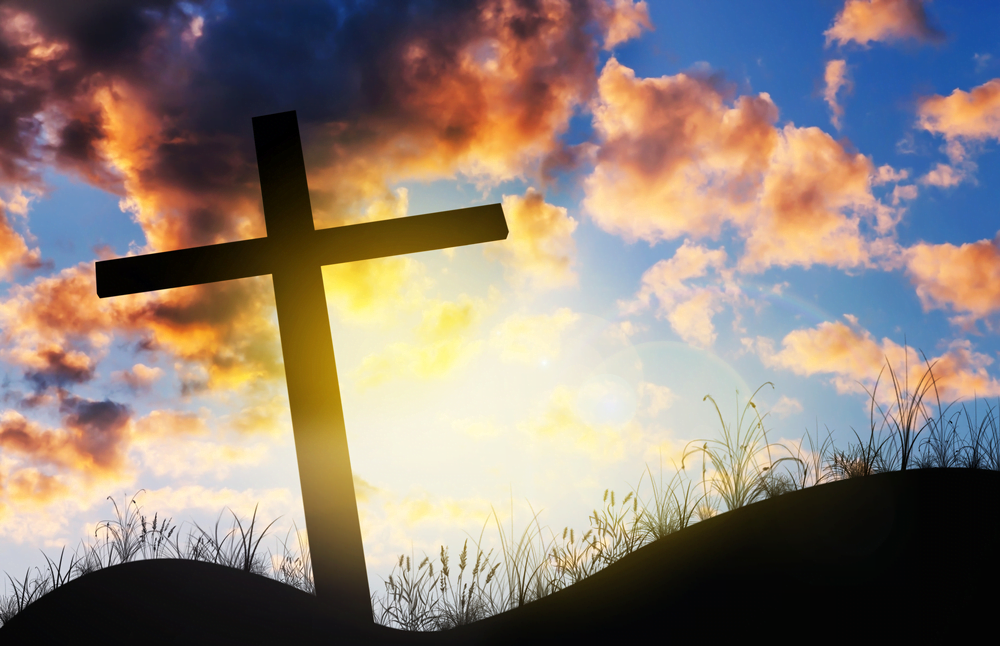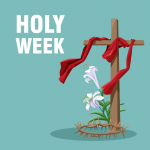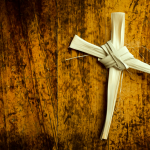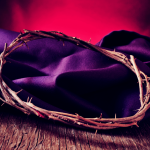
Holy Tuesday is the Tuesday of Holy Week, and the last Tuesday before Easter Sunday. It is the third day of Holy Week after Palm Sunday and Holy Monday in Western Christianity, And the fourth day of Holy Week after Lazarus Saturday, Palm Sunday, and Holy Monday in Eastern Christianity.

Depending on the Christian denomination, Holy Tuesday may or may not be celebrated. Those who celebrate this day, usually mark it with readings of scriptural passages and the singing of hymns concerned.
Holy Tuesday of Holy Week |
||
| Commemorates the Parables – Fig Tree Withering – Olivet Discourse – The Temple Debates | ||
What is Holy Tuesday?
Holy Tuesday, also called Great and Holy Tuesday is the Tuesday of Holy Week that falls after Palm Sunday and Holy Monday. The day is followed by Spy Wednesday, Maundy Thursday, Good Friday, Black Saturday, and Black Saturday.
This day commemorates some of the important events that happened during Jesus’ last day in Jerusalem. These events include:
- The Withering of Fig Tree (Mark 11:20–25)
- The Temple Debates (Matthew 21:23-27)
- The Parable of the Two Sons
- Jesus’ Voes against Pharisees (Matthew 23:13-36)
- The Olivet Discourse (Matthew 24-25; Mark 13; Luke 21:5-36)
- The Parable of Ten Virgins
Holy Tuesday is observed in Catholic and Orthodox Churches, with the readings of particular scriptural passages, singing of Holy Tuesday hymns, and Bridegroom Matins service.
Holy Tuesday Calendar: A Complete Timeline of Holy Tuesday Dates in Catholic and Orthodox Churches
- Holy Tuesday Catholic 2022: 20 Feb
- Holy Tuesday Orthodox 2022: 21st Feb
- Holy Tuesday Greek Orthodox 2022: 21st Feb
Holy Tuesday Date Calendar (-2025) |
|||
| Year | Event | Orthodox Date | Catholic Date |
| Holy Tuesday | 3 April | 27 March | |
| Holy Tuesday | 23 April | 16 April | |
| Holy Tuesday | 14 April | 7 April | |
| Holy Tuesday | 27 April | 30 March | |
| 2022 | Holy Tuesday | 19 April | 12 April |
| 2023 | Holy Tuesday | 11 April | 4 April |
| 2024 | Holy Tuesday | 30 April | 26 March |
| 2025 | Holy Tuesday | 15 April | 15 April |
From Tuesday of Holy Week to Easter Sunday

| Easter Sunday)”}”>Holy Week Days (Holy Tuesday to Easter Sunday) | |||||
| Holy Week Day | Significance | ||||
| Palm Sunday | Jesus’ Triumphal Entry into Jerusalem | ||||
| Holy Monday | Cursing of the Fig Tree – Temple Cleansing – Jesus Authority Questioned | ||||
| Holy Tuesday | Commemorates the Parable of the Ten Virgins and the Parable of the talents | ||||
| Holy Wednesday | Commemorates the Bargain of Judas and the Parable of the Two Debtors | ||||
| Holy Thursday | Commemorates the Maundy and Last Supper of Jesus Christ | ||||
| Holy Friday | Commemorates the crucifixion and death of Jesus Christ | ||||
| Holy Saturday | Marks the day Jesus’ body lay in the tomb and the Harrowing of Hell | ||||
| Easter Sunday | Celebrates the resurrection of Jesus from the dead | ||||
What Happened on Holy Tuesday?
What happened on Holy Tuesday? – There are many important biblical events that took place during the Tuesday of Holy Week.
The common interpretation of the Bible shows that Holy Tuesday is when the Pharisees and chief priests made Jesus face various challenges concerning subjects like marriage in heaven, the payment of taxes to Caesar, and the source of His authority.
This is the day when Jesus told parables and frustrated the priests, and a number of God-fearing Greeks approached him. On Tuesday, it is also the day when Jesus spoke his eight “woes” to the Pharisees, as well as the night on which He gave the Olivet Discourse.
The Withering of Fig Tree on Holy Tuesday
Holy Tuesday marks the important incident of the withering of the fig tree. On Holy Monday, when Jesus approached a fig tree, he found nothing on it but leaves. Seeing this, he cursed the fig tree, and the next day on Holy Tuesday, the fig tree was withered.
(Mark 11:20–25)
In the morning, as they went along, they saw the fig tree withered from the roots. Peter remembered and said to Jesus, “Rabbi, look! The fig tree you cursed has withered!” “Have faith in God,” Jesus answered. “Truly I tell you, if anyone says to this mountain, ‘Go, throw yourself into the sea,’ and does not doubt in their heart but believes that what they say will happen, it will be done for them. Therefore I tell you, whatever you ask for in prayer, believe that you have received it, and it will be yours. And when you stand praying, if you hold anything against anyone, forgive them, so that your Father in heaven may forgive you your sins.”
The Temple Debates on Holy Tuesday
Another important event that happened on the Tuesday of Holy Week, was the Temple Debates. While Jesus was teaching his followers in a temple, the religious leaders of that time approached Jesus and questioned his authority.
The chief priests, being jealous of Jesus, were always looking for ways to kill him. So they posed various questions to Jesus, asking his authority. It was their secret agenda to trap Jesus. If Jesus claims his authority came directly from God, the priests could accuse him of blasphemy and he will be sentenced to death; if Jesus claims his authority came from himself, the priests could represent him as a foolish person in the community.
Rather than answering the priests clearly, Jesus responded with his own one of a kind question: “John’s baptism, where did it come from? Was it from heaven, or of human origin?”
This question by Jesus put the religious leaders in confusion. If they admit that John’s baptism came from heaven, they would need to admit a similar case for Jesus. If they admit that John’s baptism came from human origin, they will be stuck in a difficult situation because of John’s great popularity. So the priests simply refused to answer this question.
(Matthew 21:23-27)
Jesus entered the temple courts, and, while he was teaching, the chief priests and the elders of the people came to him. “By what authority are you doing these things?” they asked. “And who gave you this authority?”
Jesus replied, “I will also ask you one question. If you answer me, I will tell you by what authority I am doing these things. John’s baptism—where did it come from? Was it from heaven, or of human origin?”
They discussed it among themselves and said, “If we say, ‘From heaven,’ he will ask, ‘Then why didn’t you believe him?’ But if we say, ‘Of human origin’—we are afraid of the people, for they all hold that John was a prophet.”
So they answered Jesus, “We don’t know.”
Then he said, “Neither will I tell you by what authority I am doing these things.
The Parable of the Two Sons on Holy Tuesday
On Holy Tuesday, Jesus explained the Parable of the Two Sons to the priests who question Jesus’ authority. This parable by Jesus taught the priests that they have claimed God’s message but have miserably failed to by being loyal and faithful. Externally, they seem pious, but God knows their disobedient hearts.
The Parable of Two Sons was about two brothers whose old father asked them for fruit harvesting. One son accepts his father’s request, saying he will do, but in reality, he doesn’t do it. The other son tells his father he will not do this, but ends up working all day – picking fruit in the vineyard.
Then Jesus asked a question, Which of the two did his father’s will? Obviously, the one who worked, although he initially refused to do so.
This parable goes on to previous stories in Matthew about the people who are really part of the kingdom of God because they believed in John and the people who are not part of God’s kingdom because they didn’t believe John. “Tax collectors and prostitutes are going before you to God’s kingdom,” said Jesus to the religious leaders in his audience.
Matthew 21:28-32
“What do you think? A man had two sons. And he went to the first and said, ‘Son, go and work in the vineyard today.’ And he answered, ‘I will not,’ but afterward he changed his mind and went. And he went to the other son and said the same. And he answered, ‘I go, sir,’ but did not go.
Which of the two did the will of his father?” They said, “The first.” Jesus said to them, “Truly, I say to you, the tax collectors and the prostitutes go into the kingdom of God before you. For John came to you in the way of righteousness, and you did not believe him, but the tax collectors and the prostitutes believed him. And even when you saw it, you did not afterward change your minds and believe him.
The Parable of The Wicked Tenants on Holy Tuesday
The second parable that Jesus explained was the Parable of the Wicked Tenants. This time Jesus provided a far clearer picture of what he meant in his first parable, just in case the priests in the audience did not understand (which they did). This naturally provoked further anger among the priests, yet it also gave the others present a chance to hear from Jesus fully explain the consequences of the Jewish people’s disobedience over the ages.
The Parable of the Wicked Tenants talked about the landlord who purchased a plot of land and planted a vineyard. He built a wine-press, a tower, and fenced all around it. But he had to leave for somewhere. So he left it to the tenants to take care of it. Harvest time came and it was customary at the time that the landlord would receive as much as half of the grapes as payment by the farmers for the use of his land. So the landlord sent his servants to collect the grapes. But the tenants beat one of them up, stone another and killed the third one. He then sent another group and they also received the same treatment. Finally, the landowner sends his son thinking they will show him due respect and honor, but instead they killed him in the hope of gaining the vineyard for themselves.
Teaching this Parable, Jesus was actually pointing towards God, the people of Israel, and his crucifixion. For centuries, God sent the prophets to warn to the Israelites but they had been rejected and killed by the very people who were claiming to be of God in obedient to him. Jeremiah who was beaten, Zecharia who was stoned, and John the Baptist who was killed. At some point, there was no purpose in continuing to send more prophets to the people so God sent his son believing that they will respect him, but they also crucified him.
(Matthew 21:33-45)
Hear another parable. There was a householder who planted a vineyard, and set a hedge around it, and dug a winepress in it, and built a tower, and let it out to tenants, and went into another country. When the season of fruit drew near, he sent his servants to the tenants, to get his fruit; and the tenants took his servants and beat one, killed another, and stoned another. Again he sent other servants, more than the first; and they did the same to them.
Afterward, he sent his son to them, saying, ‘They will respect my son.’ But when the tenants saw the son, they said to themselves, ‘This is the heir; come, let us kill him and have his inheritance.’ And they took him and cast him out of the vineyard, and killed him. When therefore the owner of the vineyard comes, what will he do to those tenants?” They said to him, “He will put those wretches to a miserable death, and let out the vineyard to other tenants who will give him the fruits in their seasons.”
Jesus said to them, “Have you never read in the scriptures:
‘The very stone which the builders rejected has become the head of the corner; this was the Lord’s doing, and it is marvelous in our eyes’?
Therefore I tell you, the kingdom of God will be taken away from you and given to a nation producing the fruits of it.”
When the chief priests and the Pharisees heard his parables, they perceived that he was speaking about them. But when they tried to arrest him, they feared the multitudes, because they held him to be a prophet.
Woes of the Pharisees on Holy Tuesday
The Woes of the Pharisees was a list of criticism by Jesus against Pharisees – an important event that happened on Holy Tuesday. The woes are critiqué for hypocrisy and perjury by the Pharisees. They illustrate the distinctions between internal and external moral conditions. Jesus portrayed the Pharisees as hypocrites, who looked very religious from outside, but deep inside their hearts, they were full of hatred and jealousy.
The Woes of the Pharisees by Jesus were:
- They did teach people about God, but didn’t love God – nor did they allow others to enter the kingdom of heaven.
- They were preaching God but converting people into dead religion, so they turned those converts into hell two times as many as they were.
- They taught that the oaths sworn by the temple or the altar were not binding, but that it was binding if sworn by the temple’s ornament of gold or by an offering on the altar. But gold and gifts were not sacred as the temple and the altar was, but was linked to the temple or to the altar and derived a measure of weaker sacredness. The Pharisees worshiped at the temple and offered sacrifices at the altar because they knew the temple and alter were sacred. How then can they deny oath-binding value for what really was sacred?
- They did not practice some of the law’s most important elements – justice, mercy, loyalty to God. They obeyed the details of the law, but not the law’s more serious matters.
- They looked clean, yet inside were dirty with hidden worldly desires and carnality. They were filled with hate, wickedness, and self-indulgence.
- Their mask of justice had a hidden internal world of evil thoughts and feelings. They looked righteous from outside because they were diligent keepers of the law, but they were actually not righteous. Their wickedness was full. They were liked whitewashed tombs, lovely on the exterior, yet full of bones of dead men.
- They claimed they would never have persecuted and killed prophets when, in fact, they were cut out of the same tissue as the persecutors and killers: also they had killer blood in their veins.
This event of Holy Tuesday is mentioned in (Matthew 23:1–23:39)
The Olivet Discourse on Holy Tuesday
At the evening of Holy Tuesday, Jesus delivered the Olivet Discourse. The speech included Jesus ‘ detailed prophecies about future events. This was Jesus ‘ speech as he was seated on the Mount of Olives, overlooking Jerusalem City and the magnificent Temple. He and His disciples were there. There are three places where the speech is recorded. Matthew 24, Mark 13, and Luke 21.
One of the disciples of Jesus prompted the discourse as they left the Temple where Jesus had taught. The disciple, apparently struck by the beauty of the temple, said, “Teacher, behold what wonderful stones and what wonderful buildings” (Mark 13:1). The immediate response of Jesus was a striking one: “You see these great constructions? There shall not be left one stone upon the other that shall not be torn down”.
In his discourse, Jesus spoke about many signs, characterizing the important events leading up to and including the Tribulation, which will indicate His return in the near future. These included things like false Christians, wars and war rumors, killing of believers and lawlessness in the land. Jesus also highlighted some nature signs that would predict Jesus’ return in the future. Jesus said that natural disasters, like famine and earthquakes, would grow in frequency and intensity.
Jesus concluded the Olivet Discourse, with the teaching of four parables. The first is an evil servant who, on his return home, is punishable by his master (Matthew 24:45 – 51). The second is the Parable of Ten Virgins (25:1 – 13). The third parable deals with the story and the use (or misuse) of finances of three servants. Jesus ended His speech with Sheep and Goats ‘ Parable (25:31 – 46).
The Parable of Ten Virgins on Holy Tuesday
The Parable of Ten Virgins was one of the most important Parables that Jesus taught in his Olivet Discourse on Holy Tuesday. The parable is commemorated today and forms one of the important themes for the first three days of Holy Week.
Jesus told a story in the parable of the Ten Virgins about a party of virgins chosen to participate in marriage, perhaps the bridesmaids for a procession. Each of the 10 virgins had a lamp waiting for the bridegroom, which they expect at some point in the night. Five of the virgins were wise and brought oil for their lamps (so in case the lamp turns off, they add more oil and keep it lighting all night). Five of the virgins were foolish, bringing their lamps only.
At midnight, while all the virgins were sleeping, they heard the call to meet the bridegroom. All the virgins woke up to the call. The foolish virgins, realizing their lamps have turned off, demanded oil from the wise, but they rejected it, stating that if they share there will be not enough left for their use.
The brides-man arrived while the foolish virgins went here and there for the search of oil. The brides-man is then accompanied by the wise virgins. The other five virgins came too late and were not accepted.
This event of Holy Tuesday is mentioned in (Gospel of Matthew 25:1-13)
The Importance & Teachings of Holy Tuesday
Holy Tuesday is a day that commemorates many important events of Jesus’ life. This day carries with it, some very special lessons by Jesus. Especially, the different Parables, each of which has some incredible lessons for the people of Christian faith.
By cursing the fig tree, he denounced Israel symbolically as a nation and, to some extent, even denounced unsuccessful Christians (that is to say people who profess to be Christian but do not show a relationship to Christ). The presence of a fruitful fig-tree was regarded for the people of Israel as a symbol of blessing and prosperity.
Similarly, a fig tree’s absence or death symbolizes judgment and abandonment. Symbolically, the fig-tree depicted the spiritual death of Israel, who was spiritually unclean due to their sin, while being highly religious outwardly with their sacrifices and ceremonies!
It is symbolic of the religious activity of Israel – all the trappings of spirituality, but not substance – because the fig tree has leaves but nothing of fruit.
With the Parable of Two Sons, Jesus tells if you are not really truthful in your word, you are not a good man. The first son, who doesn’t wish to work on this vineyard but in the end helps to come, represents the non-believing people that were sent the message to believe in God from John the Baptist. At first they refused, just like the first son, but in the end, they ended up following God.
The second son represents the believers, who portray themselves as true believers but still commit sins. This parable teaches that if a person starts having faith in God for a few weeks and does not sin any more, he is much more welcome in the Kingdom of heaven than a person who claims to be a believer but keeps on committing horrendous sins.
With his Olivet Discourse, Jesus predicted the events that would happen before his arrival in the future. It demonstrates His viewpoint of crucial prophetic passages in the Old Testament concerning Israel and the nations and acts as a masterpiece for events at the end of time. It also explains the judgment of God on Israel, in particular, the restoration he promised at the coming of the King Messiah, and the establishment of his Messianic rule.
By teaching the Parables in his Olivet Discourse, such as the Parable of the Ten Virgins, Jesus was actually warning people of the end times. In the simplest manner of interpretation, we can recognize that the bridegroom is Jesus Christ our Lord and that the 10 virgins represent Christians delegated to meet the bridegroom.
The lamps are the Word of God, and oil is the anointing in the Holy Spirit. When the ten virgins each had their own lamps and oils, it means that by the grace of the Holy Spirit they had received the Word of God. But like a lot of people who received and accepted the word of God, they did not persevere and their oil burnt out when the bridegroom had come. So the foolish had to leave in order to get more oil. By then, the bridegroom had come, entered the wedding feast and locked the doors. Then the foolish virgins came in with their fresh oil, but the Lord told them they didn’t know who they were. In this parable, the Lord also tells that no one knows when the end times will come. Therefore, our Lord warns us, “Stay awake, for you don’t know the day or the hour will come.”
Holy Tuesday Celebrations: Learning the Prayers & Worship Services That Are Followed On The Tuesday of Holy Week!
Holy Tuesday is celebrated in different Churches across the globe. The most celebrations for this
States, and Canada. The day is usually observed with readings of different passages, singing of Holy Tuesday hymns, and commemorating the important events that occurred on this day during Jesus’ life.
Holy Tuesday in Western Christianity
In the Roman Catholic Church, the readings for Holy Tuesday are:
- Isaiah 49:1-6
- Psalm 71:1-6
- Psalm 71:15
- Psalm 71:17
- Corinthians 1:18-31
- John 13:21-33
- John 13:36-38
Holy Tuesday in the Revised Common Lectionary, which is used by the Anglican Communion, Lutheran, Old Catholic, and Methodist Churches, the scriptural lessons for Holy Tuesday are:
- Isaiah 49:1-7 (First Reading)
- 71:1-14 (Psalm)
- 1 Corinthians 1:18-31 (Second Reading)
- 12:20-36 (Gospel Reading)
The Collect for Holy Tuesday by The Book of Worship for Church and Home (1965) is:
Almighty, everlasting God, grant us so perfectly to follow the passion of our Lord, that we may obtain the help and pardon of his all-sufficient grace; through him who liveth and reigneth with thee, in the unity of the Holy Spirit, world without end. Amen.
Holy Tuesday in Eastern Christianity
In the Orthodox Church, this day is called Great and Holy Tuesday. The day begins with Vespers and hymns. In general, a Triode, written by St. Andrew of Crete is sung. This day, the Church commemorates the Parable of the Ten Virgins and depicts Christ as the Bridegroom.
The Matins service for Holy Tuesday is called the Bridegroom Service. The analogy in the center of the temple is the image of the Christ the Bridegroom, depicting Jesus with the purple robe and the thorn crown. The Matins Gospel read on this day is from the Gospel of Matthew 22:15-23:39.
In the course of the Holy Tuesday, the four Gospels are divided and read entirely during the Little Hours (the third, sixth, and ninth hour of the day), ending at John 13:31:
Third Hour—The second half of Mark
Sixth Hour—The first third of Luke
Ninth Hour—The second third of Luke
At the Sixth Hour—reading from the Book of Ezekiel 1:21-2:1
Celebrating Holy Tuesday: A Beautiful Collection of Holy Tuesday Images, Quotes, Messages & Greetings
Get a wide variety of wishing images and quotes for Holy Tuesday. This latest collection of Holy Tuesday greetings will help all Christians maintain a positive momentum throughout the Holy Week. Inspire your friends and loved ones with these best Holy Tuesday messages.
Holy Tuesday Quotes
- GLORY YE IN HIS HOLY NAME: LET THE HEART OF THEM REJOICE THAT SEEK THE LORD – Have a Great Holy Tuesday!
- And lastly, O my dear Lord, though I am so very weak that I am not fit to ask You for suffering as a gift and have not strength to do so, at least I will beg of You, grace to meet suffering well, when You, in Your love and wisdom, brings it upon me, knowing that in this way, I shall gain the promise, both of this life and of the next. Amen
- May God Bless Your Holy Tuesday. I Can Do All Things Through Christ Which Strengthener Me.
- Not by works of righteousness which we have done, but according to his mercy he saved us, by the washing of regeneration, and renewing of the Holy Ghost; Which he shed on us abundantly through Jesus Christ our Savior. Happy A Happy Holy Tuesday!
- No man hath seen God at any time. If we love one another, God Welles in us, and his love is perfected in us. Wishing you a happy Holy Tuesday and Best wishes for this Holy Week.
Holy Tuesday Messages
- It’s Tuesday of the Holy Week. Heavenly Father, thank You for my family, friends, my home, the food that nourishes me, the prayers that You have answered and everything else that I have.
- May the Lord bless you with a beautiful Tuesday!
- Hoping you all have a Happy Holy Tuesday! Thank You, Lord, for this wonderful day. I pray that You watch over my family and friends. In Jesus name. Amen
- Happy Holy Tuesday – May the Lord bless you with His loving kindness, mercy, and grace.
- Whosoever believe in him should not perish, but have eternal life. Wishing you a lovely Holy Tuesday.
Holy Tuesday Greetings
- Dear Lord, thank you for walking us to see this new day. Help us to live it to the fullest. Help us not to waste today by worrying about tomorrow or by dwelling on what happened yesterday. Please help us to trust our burdens and the things we can’t change to your hands. May we find rest in you. May your joy be my strength and your peace fill our heart. We thank you in advance for the blessings of Holy Tuesday. In Jesus’ name, we ask these things. Amen
- Good Morning. Have a Happy Holy Tuesday. God Bless
- Have a great Holy Tuesday. Choose to smile. Choose to love. Choose to be righteous in your actions. Choose to be happy.
- No matter how stormy life gets, never let it bring you down. Always smile and be thankful, because God woke us up today and every day is a blessing. Happy Holy Tuesday!
- Happy Holy Tuesday. May God pour out His love on you today. Have a blessed Holy Week.
Holy Tuesday Interesting Facts
- Holy Tuesday is the first Tuesday of Holy Week, and the last Tuesday before Easter Sunday.
- Holy Tuesday commemorates the Withering of Fig Tree, The Temple Debates, Jesus Parables, Jesus Woes Against Pharisees and The Olivet Prophecy.
- Holy Tuesday is also known by the name of Great and Holy Tuesday.
- The Matins service for Holy Tuesday is the Bridegroom Service.
- Holy Tuesday is the third day of Holy Week in Western Christianity, and the fourth day of Holy Week in Eastern Christianity.
Holy Tuesday Images
Holy Tuesday Images: A Beautiful Collection of Tuesday of Holy Week Pictures – Observing The Day in True Catholic Spirit!
An image from Holy Tuesday celebration. The day is the Tuesday before Easter Sunday.https://dayfinders.com/easter-sunday-philippines/
Holy Tuesday is the commemoration of Jesus’ Parables, Olivet Discourse, The Temple Debates, and the Fig-Tree withering.
Holy Tuesday is celebrated by people of both Catholic and Orthodox Churches.








